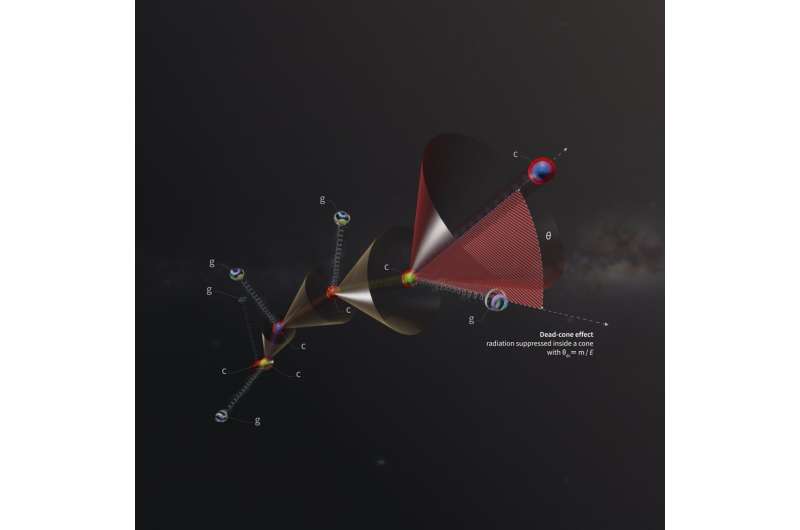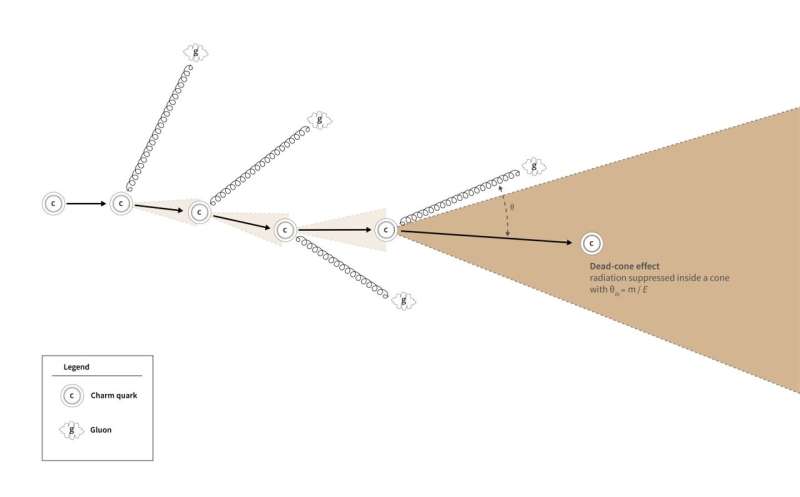First direct observation of the dead-cone effect in particle physics

The ALICE collaboration at the Large Hadron Collider (LHC) has made the first direct observation of the dead-cone effect—a fundamental feature of the theory of the strong force that binds quarks and gluons together into protons, neutrons and, ultimately, all atomic nuclei. In addition to confirming this effect, the observation, reported in a paper published today in Nature, provides direct experimental access to the mass of a single charm quark before it is confined inside hadrons.
"It has been very challenging to observe the dead cone directly," says ALICE spokesperson Luciano Musa. "But, by using three years' worth of data from proton–proton collisions at the LHC and sophisticated data-analysis techniques, we have finally been able to uncover it."
Quarks and gluons, collectively called partons, are produced in particle collisions such as those that take place at the LHC. After their creation, partons undergo a cascade of events called a parton shower, whereby they lose energy by emitting radiation in the form of gluons, which also emit gluons. The radiation pattern of this shower depends on the mass of the gluon-emitting parton and displays a region around the direction of flight of the parton where gluon emission is suppressed—the dead cone.
Predicted thirty years ago from the first principles of the theory of the strong force, the dead cone has been indirectly observed at particle colliders. However, it has remained challenging to observe it directly from the parton shower's radiation pattern. The main reasons for this are that the dead cone can be filled with the particles into which the emitting parton transforms, and that it is difficult to determine the changing direction of the parton throughout the shower process.

The ALICE collaboration overcame these challenges by applying state-of-the-art analysis techniques to a large sample of proton–proton collisions at the LHC. These techniques can roll the parton shower back in time from its end-products—the signals left in the ALICE detector by a spray of particles known as a jet. By looking for jets that included a particle containing a charm quark, the researchers were able to identify a jet created by this type of quark and trace back the quark's entire history of gluon emissions. A comparison between the gluon-emission pattern of the charm quark with that of gluons and practically massless quarks then revealed a dead cone in the charm quark's pattern.
The result also directly exposes the mass of the charm quark, as theory predicts that massless particles do not have corresponding dead cones.
"Quark masses are fundamental quantities in particle physics, but they cannot be accessed and measured directly in experiments because, with the exception of the top quark, quarks are confined inside composite particles," explains ALICE physics coordinator Andrea Dainese. "Our successful technique to directly observe a parton shower's dead cone may offer a way to measure quark masses."
More information: ALICE Collaboration, Direct observation of the dead-cone effect in quantum chromodynamics, Nature (2022). DOI: 10.1038/s41586-022-04572-w
Journal information: Nature
Provided by CERN




















